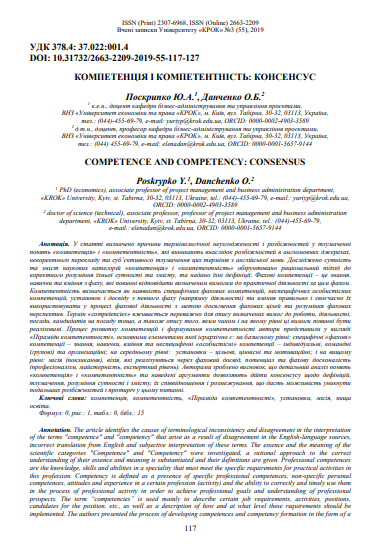COMPETENCE AND COMPETENCY: CONSENSUS
DOI:
https://doi.org/10.31732/2663-2209-2019-55-117-127Keywords:
competence, competency, Pyramid of Competency, attitudes, mission, higher educationAbstract
The article identifies the causes of terminological inconsistency and disagreement in the interpretation of the terms "competence" and "competency" that arise as a result of disagreement in the English-language sources, incorrect translation from English and subjective interpretation of these terms. The essence and the meaning of the scientific categories "Competence" and "Competency" were investigated, a rational approach to the correct understanding of their essence and meaning is substantiated and their definitions are given. Professional competences are the knowledge, skills and abilities in a speciality that must meet the specific requirements for practical activities in this profession. Competency is defined as a presence of specific professional competences, non-specific personal competences, attitudes and experience in a certain profession (activity) and the ability to correctly and timely use them in the process of professional activity in order to achieve professional goals and understanding of professional prospects. The term “competencies” is used mainly to describe certain job requirements, activities, positions, candidates for the position, etc., as well as a description of how and at what level these requirements should be implemented. The authors presented the process of developing competences and competency formation in the form of a “Pyramid of Competency”, the main elements of which are hierarchically: at the basic level: specific “professional” competences - knowledge, skills, abilities and non-specific “personal” competences - individual, team (group) and organizational; at the average level: attitudes - goal settings, value attitudes and intrinsic motivation; and at the highest level: mission, vision, which are realized through professional experience, potential and professional excellence (professional mastery, expert level). The authors concluded that a detailed analysis of the terms “competence” and “competency” and the given arguments allows reaching a consensus on definitions, interpretations, understanding of the essence and meaning, their relationship and differentiation, which will allow avoiding further differences and disagreements on this issue.
Downloads
References
Воронов С. А. Компетенция и компетентность как категории деятельности: сходства и различия в понимании. Историческая и социальная образовательная мысль. 2017. Т.9. №6. Ч.1. С. 165-172.
Рощевский Ю. К. Особенности группового поведения животных / Куйбышев: обл. типография им. Мяги. 1978. С. 9-10.
Хлебосолов Е.И. Роль поведения в экологии и эволюции животных. Русский орнитологический журнал. 2005. Т. 14. Вып. 277. С. 49-55.
ACHE Healthcare Executive Competencies Assessment Tool Healthcare Leadership / Alliance and the American College o f Healthcare Executives. 2019. 26 p. URL: https://www.ache.org/-/media/ache/career-resource-center/competencies_ booklet.pdf.
Belanich J., Moses F.L., Lall P. Review and Assessment of Personnel Competencies and Job Description Models and Methods. Institute for Defense Analyses. 2016. 33 p. URL: https://apps.dtic.mil/dtic/tr/fulltext/u2/1021552.pdf.
Eraut M. Concepts of competence. Journal of Interprofessional Care. 1998. Vol. 12. Issue 2. Pp. 127-139.
Hoffmann T. The meanings of competency. Journal of European Industrial Training. 1999. Vol. 23. No. 6. pp. 275-286.
Le Deist F.D., Winterton, J. What Is Competence? Human Resource Development International.2005. Vol. 8. Issue 1. pp. 27-46.
Moore D., Cheng M., Dainty A. Competence, competency and competencies: performance assessment in organisations. Work Study. 2002. Vol. 51. No. 6. pp. 314-319.
Multipurpose Occupational Systems Analysis Inventory – Close-Ended (MOSAIC) Competencies. United States Office of Personnel Management. 2013. 40 p. URL: https://www.opm.gov/policy-data-oversight/assessment-and-selection/competencies/ mosaic-studies-competencies.pdf.
Norris N. The Trouble with Competence. Cambridge Journal of Education. 1991. Vol. 21. Issue 3. pp. 331-341.
Spencer L., Spencer S. Competency at Work: Models for Superior Performance / John Wiley and Sons, Inc., New York. 1993. 384 p.
Teodorescu T. Competence versus competency: What is the difference? Performance Improvement. 2006. Vol. 45. Issue 10. pp. 27-30.
Weinert F.E. Concept of competence: A conceptual clarification / Defining and selecting key competencies. Rychen D. S. and Salganik L. H. (Eds.). 2001. Ashland, OH, US: Hogrefe & Huber Publishers. pp. 45-65.
Westera W. Competences in education: A confusion of tongues. Journal of Curriculum Studies. 2001. Vol. 33. Issue 1. pp. 75-88.


